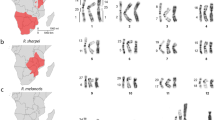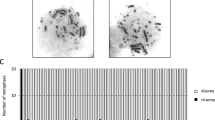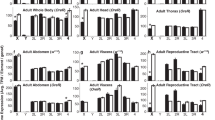Abstract
THE sex-determining mechanism in dragon-flies consists, as a rule, of XO—XX chromosomes, and the X-chromosome in the spermatocyte divides equationally in the first, and passes undivided to one pole or the other in the second, meiotic division1–4. In this respect, the X-chromosome of the male germcell in the Odonata behaves as in the Heteroptera, in which group also it usually divides in the first meiotic division only. We find that the chromosomes of the damsel-fly, Ceriagrion coromandelianum, exhibit another important feature in respect of which they resemble the hemipteran chromosomes; that feature is the presence of Feulgen-positive interconnecting threads joining the chromosomes at the spermatogonial metaphase, and also at the first and second meiotic metaphase. Such interconnecting chromatic threads are known to exist in many hemipterans5–8. Associated with the presence of these threads is a high degree of heteropycnosis of autosome segments. At pachytene the paired chromosomes carry deeply stained, condensed knobs. These heterochromatic segments occur in all chromosome pairs. The interconnecting threads, in our opinion, are derived from the chromosome matrix. It is well known that the protein framework of the heterochromatic chromosomes (or chromosome segments) differs from that of euchromatic chromosomes9. It is likely that the nucleoprotein matrix synthesized by these segments is cohesive7 and that any fortuitous contact and subsequent separation between chromosomes result in the drawing out of the matrix substance into fine threads.
This is a preview of subscription content, access via your institution
Access options
Subscribe to this journal
Receive 51 print issues and online access
$199.00 per year
only $3.90 per issue
Buy this article
- Purchase on SpringerLink
- Instant access to full article PDF
Prices may be subject to local taxes which are calculated during checkout
Similar content being viewed by others
References
Oguma, K., J. Fac. Sci. Hokkaido Univ., Ser. 6, 1, 1 (1930).
Oguma, K., and Asana, J. J., J. Fac. Sci. Hokkaido Univ., Ser. 6, 1, 133 (1932).
Asana, J. J., and Makino, S., J. Fac. Sci. Hokkaido Univ., Ser. 6, 4, 67 (1935).
Chaudhuri, S. P. R., and Gupta, J. D., Proc. Zool. Soc. Bengal, 2, 81 (1949).
Wilson, E. B., J. Exp. Zool., 6, 147 (1909).
Wilson, E. B., “The Cell in Development and Heredity” (New York, 1928).
Schrader, F., J. Morph., 69, 587 (1941).
Heizer, P., J. Morph., 87, 179 (1950).
Caspersson, T., Naturwiss., 29, 33 (1941).
White, M. J. D., “Animal Cytology and Evolution” (Cambridge, 1945).
Author information
Authors and Affiliations
Rights and permissions
About this article
Cite this article
SRIVASTAVA, M., DAS, C. Heteropycnosis in the Autosome Segments of Ceriagrion coromandelianum (Odonata). Nature 172, 765–766 (1953). https://doi.org/10.1038/172765b0
Issue date:
DOI: https://doi.org/10.1038/172765b0
This article is cited by
-
Sex chromosomes and sex determining mechanisms in Odonata, with a review of the cytological conditions in the familyGomphidae, and references to the karyotypic evolution in the order
Genetica (1969)
-
Variation in size of the dragonefly m-chromosome, with considerations on its significance for the chorogeography and taxonomy of the order odonata, and notes on the validity of the rule of reinig
Genetica (1968)



